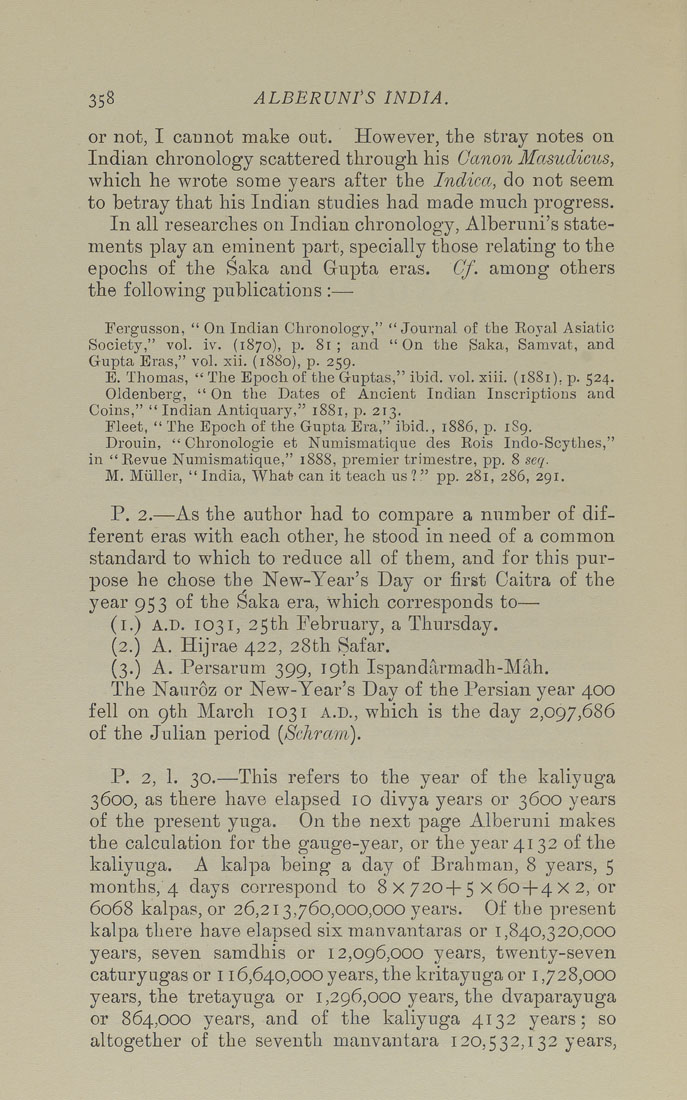358 ALBERUNTS INDIA.
or not, I cannot make out. However, the stray notes on
Indian chronology scattered through his Canon Metsudicus,
which he wrote some years after the Indica,, do not seem
to betray that his Indian studies had made much progress.
In all researches on Indian chronology, Alberuni's state¬
ments play an eminent part, specially those relating to the
epochs of the Saka and Gupta eras. Cf. among others
the following publications :—
Fergusson, " On Indian Chronology," "Journal of the Eoyal Asiatic
Society," vol. iv. (1870), p. 8i ; and "On the Saka, Samvat, and
G-upta Eras," vol. xii. (1880), p. 259.
E. Thomas, " The Epoch of the G-uptas," ibid. vol. xiii. (1881), p. 524.
Oldenberg, " On the Dates of Ancient Indian Inscriptions and
Coins," " Indian Antiquary," 1881, p. 213.
Fleet, " The Epoch of the Gupta Era," ibid., 1886, p. 189.
Drouin, " Chronologic et Numismatique des Rois Indo-Scythes,"
in "Revue Numismatique," 1888, premier trimestre, pp. 8 seq.
M. Miiller, " India, What* can it teach us ?." pp. 281, 286, 291.
P. 2.—-As the author had to compare a number of dif¬
ferent eras with each other, he stood in need of a common
standard to which to reduce all of them, and for this pur¬
pose he chose the New-Year's Day or first Caitra of the
year 953 of the Saka era, which corresponds to—
(i.) A.D. 1031, 25th February, a Thursday.
(2.) A. Hijrae 422, 28th Safar.
(3.) A. Persarum 399, 19th Ispandarmadh-Mah.
The Nauroz or New-Year's Day of the Persian year 400
fell on 9th March 1031 A.D., which is the day 2,097,686
of the Julian period (Schrctm).
P. 2, 1. 30.—This refers to the year of the kaliyuga
3600, as there have elapsed 10 divya years or 3600 years
of the present yuga. On the next page Alberuni makes
the calculation for the gauge-year, or the year 4132 of the
kaliyuga. A kalpa being a day of Brahman, 8 years, 5
months, 4 days correspond to 8 X 720-I-5 X 60-I-4 X 2, or
6068 kalpas, or 26,213,760,000,000 years. Of the present
kalpa there have elapsed six manvantaras or 1,840,320,000
years, seven samdhis or 12,096,000 years, twenty-seven
caturyugas or 116,640,000 years, the kritayuga or 1,728,000
years, the tretayuga or 1,296,000 years, the dvaparayuga
or 864,000 years, and of the kaliyuga 4132 years; so
altogether of the seventh manvantara 120,532,132 years,
|








